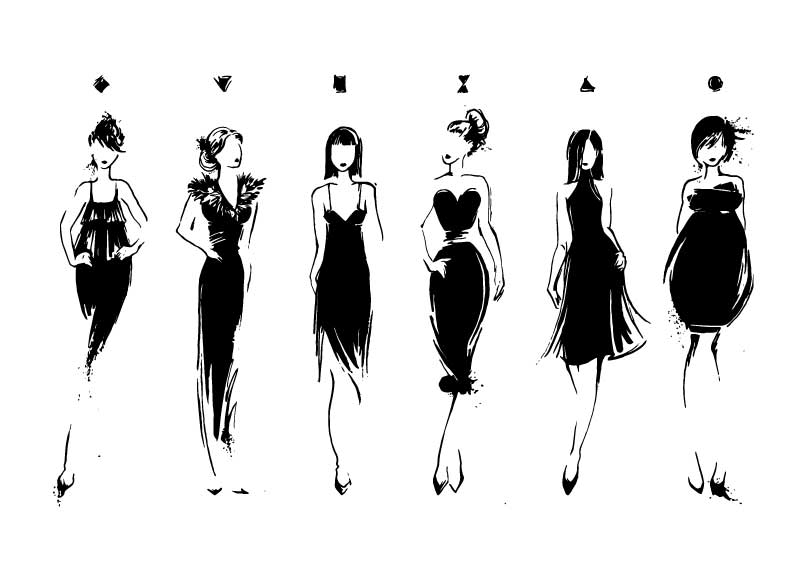BODY SHAPES
– BODY CONTOURING –You have likely heard body shapes described by different terms including “hourglass”, “apple”, and even “pear”, but which are you? When asked, women see themselves as having many different shapes with a wide range of names. Some of the most common body shapes are:
- Neat Hourglass
- Apple
- Pear
- Rectangle
- Lean Column
- Inverted Triangle or V-shaped
The most common shape women wish themselves as having, is an hourglass shape. Despite this, there are many different body shapes, with an hourglass shape being one of the least common, but the most desired. Typically, designer clothes may fit a woman in size but not flatter her as they were made for a model’s neat hourglass body shape. Clothing sizes can be confusing because a woman may see that the size fits, but the particular cut of the garment was not meant for her body shape, and therefore does not look good.







Just as each individual’s personality is different, so too is their body shape. There are a number of common body shapes, including:
A. Pear – One of the most common shapes, the pear shape is defined as having hips that are disproportionately wide in relation to the upper part of the body.
B. Triangle – This body shape is defined by shoulders that are narrower than the widest part of the hips.
C. Rectangle – This body shape is defined by a silhouette that is fairly straight up and down, possibly even with a slight masculine look.
D. Inverted Triangle – The opposite of the “triangle” body shape, the inverted triangle is defined by shoulders that are noticeably wider than the hip-line.
E. Hourglass – This highly desirable body shape is defined by a round and curvy figure with a well-defined waistline and fuller hips, bust and thighs.
F. Round – The round or “apple” shape is defined by a waistline that lacks definition with the hips and butt often as wide and full as the waist.
G. Diamond – This unique shape generally features slimmer arms and calves, with most of the weight in the bust, midsection, hips and thighs.
Why Do People Have Different Body Shapes?
Despite what many people think, a woman’s shape is not determined by her overall size. Size and shape are often confused with one another. While many strive for the “perfect” body shape, the reality is that bodies come in a wonderful variety of shapes, sizes and heights. Just as you have a limited influence on how tall you end up being due to your genetics, you also have a limited influence on your frame. The way your body distributes fat cells will have an impact on your overall shape. For example, apple-shaped people carry most of their excess body fat around the stomach within their abdominal wall, while pear-shaped people carry most of their excess body fat around the hips, buttocks, and thighs.
How Is Body Shapes Influenced By Weight Gain?
The effect of weight gain on body shape is somewhat unpredictable. The body shape is influenced by bony skeleton, muscle structure, and fat cell distribution. Although weight gain does not significantly affect bony skeleton or muscle structure, it results in enlargement of all fat cells within the abdominal cavity and under the skin. It is the distribution and the number of fat cells in each area that primarily affects body shape and changes of body shape with weight gain. For example, if you have more fat cells around the trunk, then weight gain will result in an apple body shape. On the other hand, if the fat cells are mainly concentrated in the hips, buttocks, and thighs, then weight gain results in expansion of these areas and ultimately in pear shape body. Some patients have an inverted triangle shape. In these individuals, they have more fat cells in the upper body than the lower body.
What Is The Effect Of Body Shape On Skin Laxity After Weight Loss?
As mentioned above, body shape is primarily influenced by fat cell distribution. But to simplify, after weight loss, an apple shape person will probably have skin laxity and excess of the abdomen and trunk both in a vertical and horizontal dimension. Similarly, a pear-shaped person will have vertical and horizontal laxity of skin and tissue of the hips, buttocks, and thighs after significant weight loss. In these patients, measures need to be taken to reduce the excess skin in both vertical and horizontal dimensions. Thus, these patients may need additional body contouring procedures. This over-simplification is used here for the purpose of describing and anticipating what a weight loss patient may see and develop. However, in real life, our experience has shown that most weight loss patients do not fall into a typical body shape. Each patient has his/her own set of skin laxities and must be examined closely before a customized surgical plan can be developed.
Do Body Shapes Change Over Time?
Women in specific age brackets tend to identify with a particular body shape. This is because a woman’s body shape can dramatically change with age. Women in their teens and early 20s tend to have a “neat hourglass shape,” while women in their 30s and 40s often have a “full hourglass” shape. Furthermore, women in their 50’s and 60’s are most likely to have an “apple” shape.
A woman’s body shape changes as she ages, partly because she begins to put on weight in different places. This is due to a number of factors, including aging, lifestyle, child bearing, genetics and the natural distribution of fat cells.
Can Cosmetic Surgery Change a Person’s Body Shape?
As we all know, exercise can have an impact on your body shape, but it cannot completely change it. Similarly, cosmetic procedures like liposuction and body contouring can remove fat and excess tissue from the body, including in common areas like the abdomen, back, thighs and buttocks, which can alter your body shape. While body contouring does not improve an individual’s health, it can improve an individual’s quality of life by altering the body’s shape to a more aesthetically pleasing form. Dr. Agha employs liposuction, liposculpting, and body contouring procedures to completely transform an individual’s body shape to a more aesthetically revered “hourglass” look.
Dr. Siamak Agha is a board certified plastic surgeon in Orange County and Los Angeles with extensive experience in body reshaping and body contouring. If you are interested in how Dr. Agha can help you realistically achieve a particular look, especially after weight loss, contact his practice today for more information at 949-644-2442.
